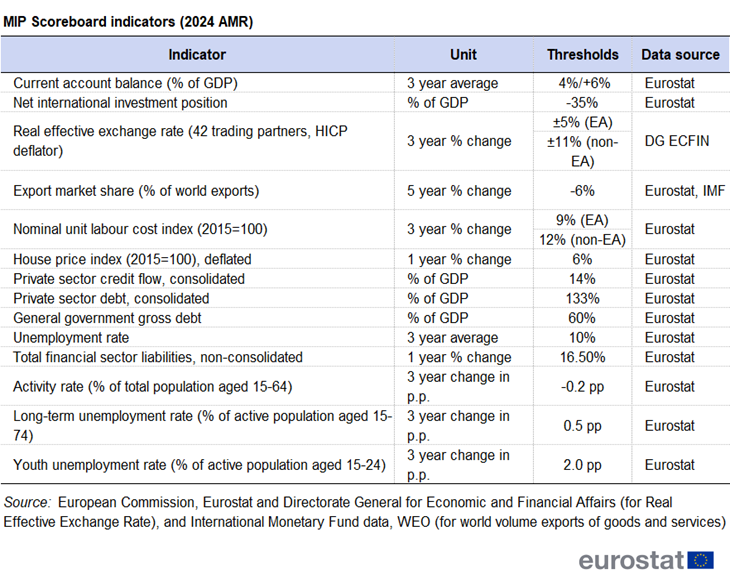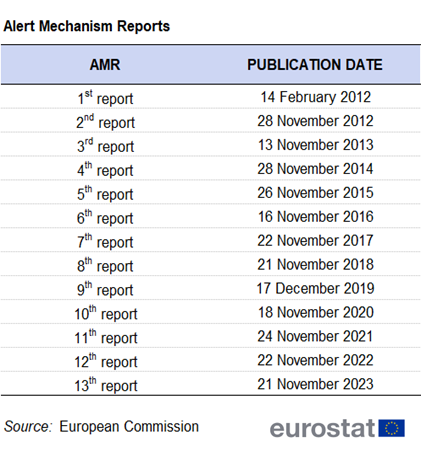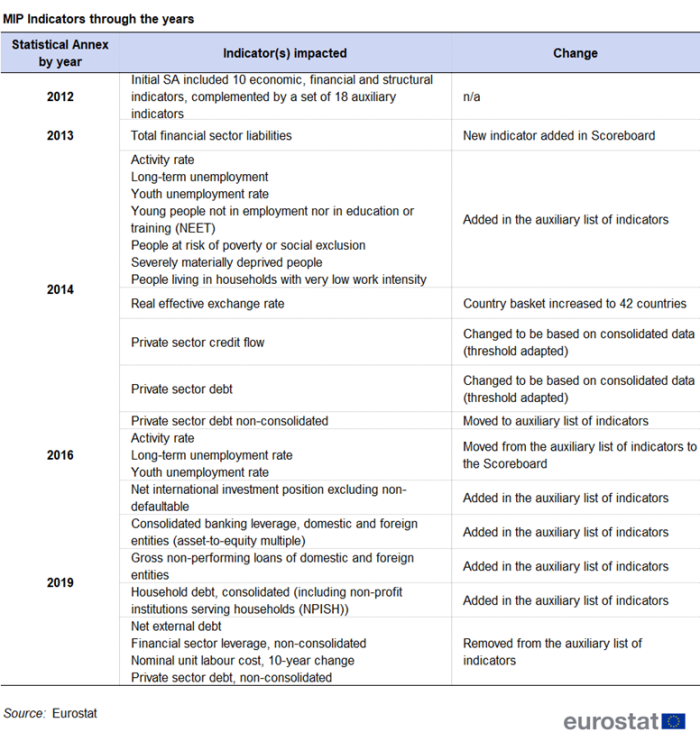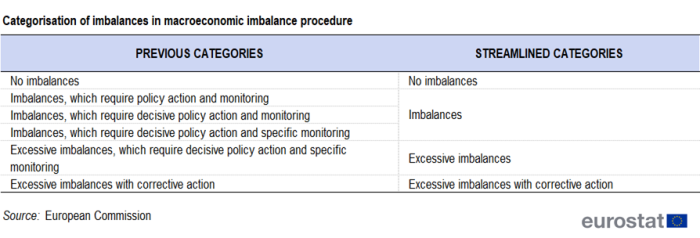The Macroeconomic Imbalance Procedure (MIP) introduced
Data extracted on 31 October 2023
Planned article update: November 2024
This article provides information on the Macroeconomic Imbalance Procedure (MIP), as well as on indicators and statistical data used in this context. The Macroeconomic Imbalance Procedure (MIP) is part of the European Semester, which enables the European Union Member States to coordinate their economic policies throughout the year, addressing economic challenges. The MIP surveillance framework aims to identify potential macroeconomic risks early on, preventing the emergence of harmful macroeconomic imbalances and allowing the correction of the imbalances that are already in place.
Full article
Background
Regulation (EU) No 1176/2011 defines a macroeconomic imbalance as:
- any trend giving rise to macroeconomic developments which are adversely affecting, or have the potential to adversely affect, the proper functioning of the economy of a Member State or of the Economic and Monetary Union, or of the European Union as a whole.
While excessive imbalances are defined in the same legal act as:
- severe imbalances that jeopardise or risk jeopardising the proper functioning of the Economic and Monetary Union.
The MIP covers a number of sequential steps, having the Alert Mechanism Report (AMR) and its Statistical Annex (SA) as a starting point, with the AMR being an initial screening device providing an economic reading of the MIP Scoreboard. The Statistical Annex and the Alert Mechanism Report are published at the same time, based on the last available annual data. The AMR for year T is published in year T – 1, with data based on year T – 2 (e.g., the 2024 AMR is published in November 2023 based on 2022 data).
Table 1 below shows the MIP Scoreboard indicators values used within the latest AMR.
Following the Commission proposal for a regulation on the effective coordination of economic policies of 26 April 2023, the MIP procedure is focused on a forward-looking perspective, on emerging risks, and on the evolution of imbalances. Great attention is given to systemic challenges and to developments in the European Union and euro area. In this context, EU and euro area aggregates have been added to the procedure and are therefore presented in the statistical annex. A note on the computation of MIP indicators for European aggregates has been published on the Eurostat website.
The Macroeconomic Imbalance Procedure (MIP) in the context of the European Semester
Since 2010, the European Union is running a cycle of economic policy coordination called the European Semester to ensure that EU Member States coordinate their efforts to maximise the impact on growth, and discuss their budgetary and economic plans as well as structural reforms with their EU partners at specific times throughout the year.
The European Semester follows a precise timeline. The cycle starts in autumn with the publication of the Commission's Annual Sustainable Growth Survey (ASGS), the Alert Mechanism Report (AMR), the proposal for a Joint Employment Report, a proposal for recommendations for the euro area, and Commission opinions on the draft budgetary plans of euro area Member States. The ASGS sets out general economic and social priorities for the EU and provides Member States with policy guidance for the following year.
The Alert Mechanism Report is the starting point of the annual Macroeconomic Imbalance Procedure (MIP). The MIP aims to identify potential risks early on, prevent the emergence of harmful macroeconomic imbalances and correct any imbalances that have already materialised. The MIP is supported by the analysis of a set of headline and auxiliary indicators, the scrutiny of which could trigger further analysis at country level. Eurostat is in charge of producing the Statistical Annex to the AMR, a document presenting the MIP indicators for a 10-year period for each Member State and, since 2023, for the European union and the euro area.
Based on the AMR, the Commission decides for which countries it will prepare country-specific in-depth reviews (IDR) that encompass a thorough assessment of imbalances in the Member State under review, taking into account country-specific economic conditions. The IDRs can consider a wide set of available data – starting with the MIP Scoreboard – and other relevant information, also assessing the euro area dimension of macroeconomic imbalances. Based on IDRs, the Commission concludes whether imbalances or potentially excessive imbalances exist and puts forward the appropriate country-specific recommendations.
After publication of the IDRs, Member States present their National Reform Programmes (NRPs) and Stability or Convergence Programmes: these contain reforms and measures envisaged to make progress towards smart, sustainable, and inclusive growth, as well as the countries' plans for sound public finances. The Council completes the European Semester in the summer by agreeing on a set of country-specific recommendations, highlighting areas where European Union Member States need to take further actions to boost growth, job creation, training and education opportunities, research and innovation.
The European Semester cycle was adapted to coordinate with the Recovery and Resilience Facility (RRF). NRPs play now a dual role. Besides their role for the European Semester, NRPs also fulfil the role of the two bi-annual reporting requirements of Member States under the RRF.
Outcome of the 2024 AMR
The new Alert Mechanism Report (AMR 2024) was published on 21 November 2023. The economic reading of the scoreboard considers outcomes for 2022 and is interpreted in light of available data for 2023 and the Commission’s 2023 autumn forecast. This report considers the evolution of macroeconomic imbalances at a time of still high but declining inflation and weak economic growth, while the economy is still vulnerable to economic uncertainty. The Alert Mechanism Report identifies the Member States for which further analysis (in the form of in-depth reviews) is deemed necessary for deciding whether an imbalance in need of a policy action exists. Imbalances that require close monitoring and, possibly, policy interventions relate to developments that could threaten macroeconomic stability.
In 2024, In-depth reviews will be prepared for the 11 Member States that were identified as experiencing imbalances in 2023: Cyprus, France, Germany, Greece, Italy, Hungary, the Netherlands, Portugal, Romania, Spain, and Sweden. In addition, the economic reading of the scoreboard leads to the conclusion that an IDR will also be undertaken for Slovakia, as it presents particular risks of newly emerging imbalances.
The MIP indicators
MIP indicators cover external and internal imbalances, competitiveness positions, labour market and social aspects. They are calculated from several statistical areas, including national accounts, balance of payments statistics, price statistics, excessive deficit procedure (EDP) statistics, labour market and living conditions statistics. Indicators stemming from the National Accounts (NA), Balance of Payments (BoP) and International Investment Position (IIP) domains are computed following the European System of Accounts 2010 (ESA 2010) and the Balance of Payments and International Investment Position Manual, 6th edition (BPM6) that guarantee a high level of comparability and internal consistency across European Union Member States.
A three-level quality assurance framework ensures the quality of the MIP indicators. The first level assesses the reliability and comparability of indicators underlying statistics and addresses relevant quality issues; it enhances the communication on quality assurance of MIP statistics towards the European Parliament and Council, policy makers and the public at large by the annual publication of a quality report. This report draws on the information gathered in levels two (domain-specific quality reports produced by Eurostat and the ECB) and three (national quality reports/self-assessments produced by the institutions compiling the national statistics).
The MIP Scoreboard is a tool to support the early identification and monitoring of imbalances, and it comprises a limited number of relevant and high quality macroeconomic, financial, and social indicators. Each scoreboard indicator has indicative thresholds serving as alert levels. However, not all imbalances necessarily require policy intervention because they might be justified by an economy's dynamic adjustment, so that scoreboard indicators should not be interpreted mechanically. Moreover, their economic reading is complemented by the analysis of a wider set of auxiliary indicators that do not have any associated threshold.
Data sources
The MIP Scoreboard and auxiliary indicators are mainly compiled by Eurostat, from the data transmitted by Member States, following European legislation, although some data are produced by the Commission's Directorate General for Economic and Financial Affairs (DG ECFIN), the European Central Bank (ECB) for two auxiliary indicators on banking data, and one denominator is produced by the International Monetary Fund (IMF). The composition of the indicators set is subject to review and it may evolve over time in order to reflect new developments or needs.
MIP indicators in the 2022 Statistical Annex (SA)
The Scoreboard for the 2024 AMR consists of fourteen scoreboard indicators with indicative thresholds: these indicators cover external imbalances and competitiveness, internal imbalances, labour market and social issues. Detailed information about the rationale behind the choice of these specific indicators can be found in The Macroeconomic Imbalance Procedure (Institutional Paper, 2016). Supplementing the MIP Scoreboard indicators, a list of auxiliary indicators provides additional information on aspects linked to the general macroeconomic situation. Auxiliary indicators (see Table 3) enhance the information base for understanding potential imbalances, as well as the adjustment capacity of a Member State's economy.
Recent statistical improvements
Looking at data quality, and in particular to cross-domain consistency, the implementation of the harmonised European revision policy (HERP) for National Accounts and Balance of Payments statistics, covering benchmark and routine revisions, is progressing on a voluntary basis. All Member States have now carried out benchmark revisions since the introduction of ESA 2010 in September 2014, improving the overall quality and consistency of data through further improvements in the methodology, sources or estimation techniques applied. Eurostat has been working on the reconciliation of the Balance of Payments and the Rest of the World (RoW) account at national level, and regularly assesses the state of consistency between Balance of Payments and National Accounts statistics.
In the Balance of Payments domain, progress has been made on addressing asymmetries in statistics for trade in goods and services. Eurostat carried on activities to further reduce asymmetries, in particular the follow up of some of the recommendations resulting from the previous ITSS asymmetry study, an ongoing initiative to obtain the Member States’ VIES (VAT Information Exchange System) data for the intra-exports side, and the development of a flexible tool to exchange information on compensation of employees. In addition, Eurostat is facilitating bilateral and multilateral reconciliation exercises to reduce asymmetries in data on foreign direct investment (together with ECB) and on international trade in services.
Eurostat published a guidance note titled “Next Generation EU - Statistical recording in balance of payments (BOP)”. The note recommends the statistical recording of additional funds generated by the EU’s borrowing, their disbursement to the Member States as grants and loans via the existing instruments of the Multi-annual Financial Framework (MFF) and the recording of new NGEU instruments. Eurostat also published, in 2022, a guidance note, based on BPM6 and ESA 2010, on the statistical recording of cross-border transactions related to the Russian aggression against Ukraine: this note provides basic guidance to compilers for recording related balance of payments transactions in the current, capital and financial account.
In the domain of Financial Accounts, regarding total financial sector liabilities, work is ongoing to ensure a comprehensive and timely coverage of “Other Financial Institutions” (OFIs), on the recording of other equities, derivatives, loans between non-financial corporations, foreign-controlled corporations, and on vertical discrepancies with non-financial sector accounts. On the latter, Eurostat and the ECB published a report with recommendations aiming at improving vertical consistency across institutional sectors to enhance cross-country comparability.
Concerning the Labour Force Survey (LFS), in 2021, the EU regulation 2019/1700 (Integrated European Social Statistics Framework regulation, IESS FR) entered into force, together with its LFS implementing regulation (the EU regulation 2019/2240). Innovations concern all aspects of the survey, in order to harmonise survey fundamentals among countries. Together with the IESS regulation, several countries introduced national specific innovations. Due to pre-existing differences among national surveys, it is not possible to assess the overall impact of the new regulation on the survey results: the further a country was from the harmonised new standards the more that country was affected by the change. Some countries show figures in line with those of the old LFS series, while others declare relevant breaks. Consistency in MIP Scoreboard indicators stemming from the LFS has been ensured thanks to back-calculation, as required by the new regulation. Although labour market indicators in the MIP Scoreboard may show different figures than in the past, including in the initial part of the series, series are consistent over time and multi-annual indicators are calculated with consistent figures.
In the House Prices domain, the Commission Implementing Regulation (EU) 2023/1470, which lays down the methodological and technical specifications of the house price index and the owner-occupied housing price index, was adopted in 2023. This regulation will start producing effects from January 2024.
General Government gross debt data notified for the years 2019 to 2022 were released, within the EDP notification, on 23 October 2023. For more information on the main revisions between the April and October 2023 notifications, please see the latest EDP news release. Timeliness and availability of general government gross debt data remained excellent. In February 2023, Eurostat published an updated version of the Manual on Government Deficit and Debt.
In 2022 there was a change in concepts in the domain of Income and Living Conditions (EU-SILC) in order to better measure deprivation, based on a revised list of items, as well as to better account for the social exclusion situation of people in the working age group (aged 18 to 64 instead of 18 to 59). This change impacted on three MIP auxiliary indicators: People at risk of poverty or social exclusion, severely materially and socially deprived people, and people living in households with very low work intensity. Following the entry into force of the Regulation (EU) 2019/1700, timeliness improved further for the EU-SILC 2022 data.
Published AMRs
The complete list of the AMRs, Statistical Annexes and Eurostat's press releases are published on the MIP dedicated web section. Detailed information on the current situation and previous reports is published on the web section of DG ECFIN. Table 4 shows the publication dates of the different editions of the AMRs.
In the 2016 AMR, in order to ensure more effective and simpler communication, the macroeconomic imbalances categories have been streamlined from six to four: no imbalance, imbalances, excessive imbalances, and excessive imbalances with corrective action.
LEGISLATION:
The rules on economic governance (introduced through the Six Pack, the Two Pack (Regulation (EU) No 472/2013 and Regulation (EU) No 473/2013 of 21 May 2013) and the Treaty on Stability, Coordination and Governance) are grounded in the European Semester - the EU's annual cycle of economic policy guidance and surveillance. The fully-fledged mechanism for the prevention and correction of macroeconomic imbalances is made up of two regulations:
- Regulation (EU) No 1176/2011 of 16 November 2011 on the prevention and correction of macroeconomic imbalances - sketching out the excessive imbalances procedure
- Regulation (EU) No 1174/2011 of 16 November 2011 on enforcement measures to correct excessive macroeconomic imbalances in the euro area - focusing on the associated enforcement measures.
For more information on the design of and technical explanations about the MIP Scoreboard and the thresholds for the different indicators, see the publication: Scoreboard for the surveillance of macroeconomic imbalances (Directorate-General for Economic and Financial Affairs, European Commission Occasional Paper 92/2012).
Direct access to
Methodological information on the indicators is published on the Eurostat MIP methodology web section and in the respective metadata files:
- Current account balance and balance of payments (ESMS metadata file — tipsbp_esms)
- International investment position (ESMS metadata file — tipsii_esms)
- Net external debt (ESMS metadata file — tipsed_esms)
- Real effective exchange rate (ESMS metadata file — tipser10_esms)
- Export market shares (ESMS metadata file — tipsex_esms)
- Nominal unit labour cost (ESMS metadata file — tipslm10_esms)
- House price indices (ESMS metadata file — tipsho_esms)
- Private sector credit flow (ESMS metadata file — tipspc_esms)
- Private sector debt (ESMS metadata file — tipspd_esms)
- General government gross debt (ESMS metadata file — tipsgo10_esms)
- Quarterly government debt (ESMS metadata file — gov_10q_ggdebt_esms)
- Unemployment rate (ESMS metadata file — tipsun_esms)
- Total financial sector liabilities (ESMS metadata file — tipsfs_esms)
- Activity rate (ESMS metadata file — tipslm60_esms)
- Annual national accounts (ESMS metadata file — na10_esms)
- Quarterly national accounts (ESMS metadata file — namq_10_esms)
- Statistics on research and development (ESMS metadata file — rd_esms)
- International trade in goods (ESMS metadata file — ext_go_esms)
- Poverty and social exclusion (ESMS metadata file — tipspo_esms)
- DG ECFIN MIP dedicated web section
- DG ECFIN web section: In-depth reviews
- European Semester dedicated web section





